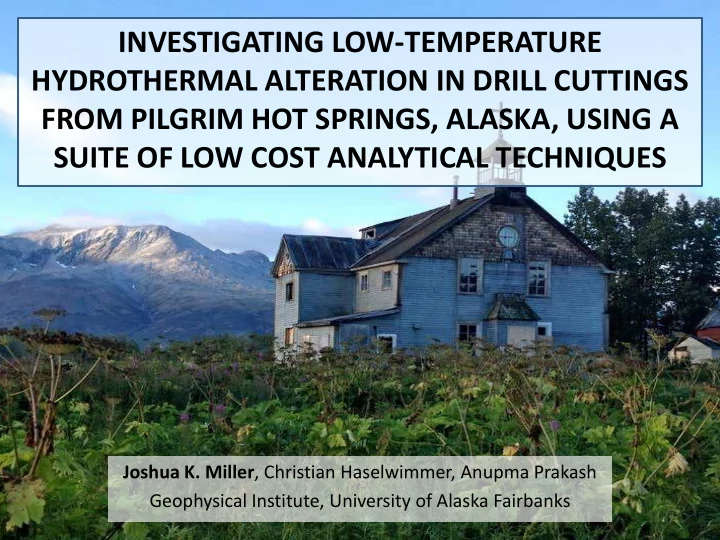

INVESTIGATING LOW-TEMPERATURE HYDROTHERMAL ALTERATION IN DRILL CUTTINGS FROM PILGRIM HOT SPRINGS, ALASKA, USING A SUITE OF LOW COST ANALYTICAL TECHNIQUES Joshua K. Miller , Christian Haselwimmer, Anupma Prakash Geophysical Institute, University of Alaska Fairbanks
Acknowledgements Research funding provided by Department of Energy Geothermal Technologies Programme (CID: DE-EE0002846) and the Alaska Energy Authority Renewable Energy Fund Round III Project team headed by Gwen Holdmann (ACEP, Director), consultants William (Bill) Cumming and Dick Benoit, as well as many other organizations:
Overview • Pilgrim Hot Springs Geothermal System – Conceptual Model • Analytical Methods – Reflectance Spectroscopy – Methylene Blue Titration – X-ray Diffraction • Summary of Results • Conclusions
Pilgrim Hot Springs • 1.5 km 2 • 91°C at 12 m depth • 26-28 MW thermal • 2.6-2.8 MW electric (Chittambakkam et al., 2013)
Conceptual Model
Reflectance Spectroscopy Reflectance spectroscopy is the • Montmorillonite interaction of light with a medium USGS Reference Sample that absorbs specific wavelengths that produces characteristic spectrums. Absorption Reflection (Ruitenbeek et al., 2005)
Reflectance Spectroscopy PS-12-2 Hyperspectral Cube (Calvin et al., 2010) 120 sediment • samples 7 cm intervals • over 15 m of core Bandwidth • – R: 2145 nm – G: 2205 nm – B: 2235 nm
Reflectance Spectroscopy PS-12-2 Sediments MgChlorite Muscovitic Illite Muscovite FeMgChlorite Clays Siderite Kaolinite 0 5 10 15 20 25 30 Montmorillonite PS-12-2 Core Hornblende Biotite Ankerite Siderite Calcite Muscovite Micas Muscovitic Illite Montmorillonite MgChlorite Phlogopite FeMgChlorite 0 5 10 15 20 25 30
Methylene Blue Titration Determining presence of smectite • clay Conductive signature • 28 sediment and bedrock samples • for PS-12-2
X-ray Diffraction 4, 20 m vertically-spaced • samples Reflectance Spectroscopy & • Methylene Blue results comparison Oriented <2 µm clay • particles and saturated with ethylene glycol (M)ontmorillonite, (I)llite, • (B)iotite, (K)aolinite detected
Conclusions • Abundant montmorillonite, kaolinite, white micas, and illite detected • Possible indicators of hydrothermal alteration assemblages • Techniques applicable as quick, cheap assessment of alteration in low-temperature geothermal systems
Extra Slides
Temperate Modeling S N W E N W S E
Geologic Data
Groundwater flow
Biotite schist Pegmatitic dike Diabase dike Biotite schist/pegmatitic dike contact
Recommend
More recommend